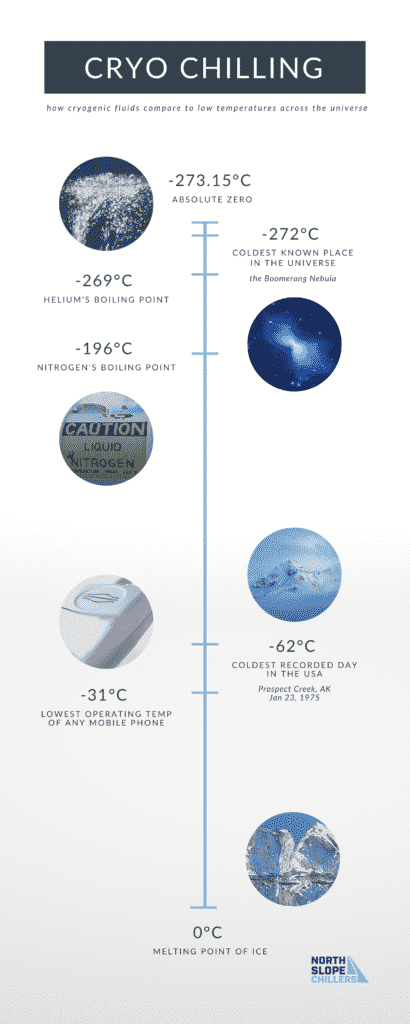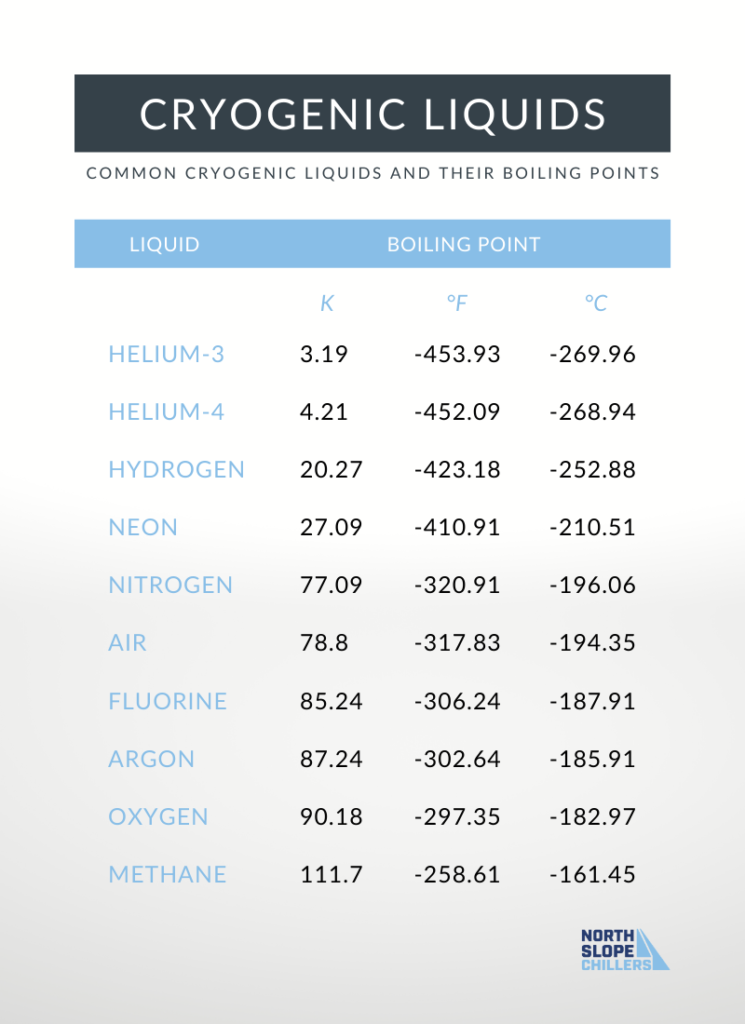Cryo Chilling is super cool. Like -238 °F (-180°C) cool. Unlike traditional methods of cooling, cryo chilling uses the lowest attainable temperatures on earth. These insanely low temps allow us to do some pretty cool things like create superconductivity, facilitate specific chemical reactions, and easily pulverize materials for recycling

What is Cryogenics?
Cryogenics is a discipline of physics that focuses on creating and experimenting with extremely low temperatures. While there is no universal standard that defines the temperature at which cryogenics begins, the U.S. National Institute of Standards and Technology considers -180°C (123 K, -238 °F) the starting point of cryo chilling.


How cryo chilling works
Cryogenic chilling is possible thanks to cryogenic fluids: helium, hydrogen, neon, nitrogen, air, fluorine, argon, oxygen and methane. Because these elements are naturally in a gaseous state, extremely technical multi-step manipulation is required to condense them into liquids.
Liquid nitrogen is the most commonly used element in cryo chilling and is legal to purchase anywhere in the world. Liquid helium is also frequently used and allows for the lowest attainable temperatures.
Cooling/freezing can be achieved via a few different methods. In one method, a liquid cryogenic is kept in a storage vessel and piped to the area to be cooled. The liquid then returns to the vessel. Submersion freezers are another common cyro chilling system. Other common systems involve surrounding the workpiece with a low temperature vapor.
Disciplines of Cryogenics
While cryogenics refers to the physics of utilizing extremely low temperatures, within this application of science are several more specific disciplines. Let’s take a look a quick look at each:
Cryobiology
Cryobiology involves the study of the effects of low temperatures on organisms. Most often, this application is used to achieve cryopreservation.
Cryopreservation
Cryopreservation is the cryogenic preservation of genetic material with the goal of preserving a breed.
Cryosurgery
Cryosurgery uses cryogenic temperatures to destroy malignant tissue such as cancer cells.
Cryoelectronics
Cryoelectronics is the study of electronic phenomena at cryogenic temperatures. This includes superconductivity and variable-range hopping.
Cryotronics
Cryotronics includes the practical applications of cryoelectronics.
Cryonics
Thanks to its appearance in sci-fi and pop culture, cryonics is one of the better-known applications of cryogenics. Cryonics is the cryopreservation of humans or animals with intent to revive in the future.
History of Cryogenics
In 1908, after successfully liquefying helium, Lamerlingh Onnes began studying the properties of various materials kept at cryogenic temperatures. He first began studying the electrical resistance of metals at these extremely low temperatures. Before his experiments, it was presumed that electrical resistance would completely disappear at exactly absolute zero. However, Onnes discovered that for some metals, resistance dropped very suddenly to zero at temperatures above absolute zero. This effect is called superconductivity.
During World War II, scientists discovered that metals that went through a cryo chilling process displayed greater resistance to wear and tear. This led to the commercialization of cryogenic hardening in the 1960s. In 1965, Ed Busch founded CryoTech. This company was the first cryogenic processing facility and experimented in increasing the life of metals tools between 300%-500%
Applications of Cryo Chilling

When it comes to cryogenics, the possibilities are only limited to our imaginations! While this list is by no means exhaustive, it covers just a few of our favorite examples of cryo cooling in action.
NMR and MRI
Nuclear Magnetic Resonance (NMR) is one of the most common ways to determine the chemical and physical properties of atoms. Typically, this is done by cryo chilling electromagnets to limit resistance and generate strong magnetic fields. Next, scientists monitor the radiofrequency absorbed and subsequent relaxation of the nuclei exposed to the magnetic field. Chemists use NMR to determine molecular identity and structure.
Magnetic Resonance Imaging (MRI) is a more complex application of NMR used frequently in the medical field. MRI technology uses the resonances produced by cryo chilled electromagnets to generate a detailed image of internal body structures.
Medical
Beyond MRI, cryogenics is used often throughout the medical field.
As mentioned earlier, cryosurgery uses cryogenic temperatures to destroy malignant tissue such as cancer cells. This can be done on internal and external tumors as well as tumors in the bone. For internal tumors, a cryoprobe is used. Argon gas or liquid nitrogen passes through the probe and onto the malignant cells. Ice crystals form in the cells, decrease the cell density, and the cells tear themselves apart.
Cryogenic chilling is also used to produce certain pharmaceuticals like statin drugs. The chemical reactions necessary for the production of these drugs require low temperatures, typically around -100 °C (-148 ° F).
Electronics
Cryoelectronics is a relatively new field and many studies are still going on to develop revolutionary applications. Such studies typically involve the utilization of superconductivity made possible by cryo chilling.
Currently, scientists are working on using cryoelectronics to mass produce computers at a cheaper cost.
In large cities where underground electric power cables are used, increased resistance and heat causes a good chunk of power to go to waste. Superconductors could increase power throughput; this would require the use of cryogenic cooling of cables.of cryogenic chiller systems on cables.
Recycling
Some recyclable materials like rubber and soft plastics are not easily milled for reprocessing. With cryo freezing, however, items are immersed in liquid nitrogen then shattered and pulverized for easy separation and reprocessing.
Manufacturing
In metal fabrication, cryogenic chiller systems can be an important part of heat tempering processes. To increase the strength of the metal, after it is heated and molded/fabricated, cryogenic chilling cools the material to approximately – 196°C (78 K, 320°F). Typically, this is followed by a heat tempering procedure.
During manufacturing processes that involve machining, cryogenic process chillers are used to cool the tool tips. This increases the tool life and helps maintain product quality.
Cryogenic process chillers are also used throughout the manufacturing industry to remove unwanted heat from manufacturing processes.
Food Transportation and Storage
When large quantities of food are stored and transported, cryogenic gases are used to keep food frozen.
Aerospace
It’s thanks to cryogenic fuel that rockets make it into orbit. Most commonly, liquid hydrogen is used as fuel and liquid oxygen is used as an oxidizer.
Dining & Entertainment
Cryogenics are often used to create special effects at shows, night clubs, and even in movies.
Some restaurants even use cryogenic gases to add special effects to drinks and dishes.
Infrared Cameras
Because infrared cameras create images by detecting heat, the camera itself can’t be warmer than the object it’s recording. Cryo process cooling is used to keep the camera and equipment cool.
The Future of Cryo Cooling

Applying cryo cooling to various processes continues to open doors to new possibilities. We’re excited to see what these sub zero chillers make possible in the next five, ten, and twenty years!

